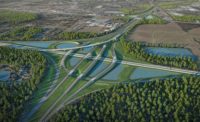As 2020 began, Southeast design firms and contractors seemed to be preparing for at least one more year of solid growth across most geographic markets and project sectors. Worries from 2019 about a coming recession had largely faded, and all seemed to be progressing as anticipated.
In March, ENR Southeast, as part of its annual Top Starts ranking of major projects, reported that firms working in the region were significantly optimistic about the coming year, with an engineer offering this assessment of the health care market: “The market is certainly hot, and as long as population growth continues to be realized, the Southeast will continue to grow.”
In that same report, a Southeast contractor told ENR that 2019 had been “the best year ever” for his company, adding that “revenue and profitability look even better for 2020.”
Then, a couple of weeks later, the global coronavirus pandemic swept across the U.S., and everything changed. Mayors and governors across the country shut down construction projects and otherwise shuttered large sectors of the economy.
Hospitals and health care providers were particularly hard hit as doctors and nurses battled on the pandemic’s front lines. In response, the U.S. Senate on April 21 approved $75 billion to assist hospitals and health care workers in the battle against COVID-19.
By early April, though, some optimism began to surface. For example, a Dodge Data & Analytics forecast on COVID-19’s potential impact on construction starts noted that the “recession will be short lived.”
As ENR reported, the Dodge forecast said by late summer the economy would “start to slowly return to normal.”
While it’s too early to discern all of the future impacts the pandemic with have on the Southeast’s construction industry, let’s first look back at 2019’s results.
|
Related Link |
Survey Findings
This year, approximately 125 engineering and architectural firms working across the states of Florida, Georgia, North Carolina, South Carolina and Tennessee as well as Puerto Rico participated in ENR Southeast’s annual Top Design Firms survey.
In all, respondents collectively reported more than $6.8 billion in 2019 revenue from the Southeast region. The roughly $800-million gain equaled a 14% increase over last year’s reported total of $6 billion.
Firms that made the top 20 of this year’s ranking continued to garner most of the increase, collectively reporting nearly $4.1 billion in Southeast revenue.
Design revenue attributed to projects in all six Southeast states increased compared with last year’s survey. Again leading the way was Florida, where 2019 revenue reported from this year’s survey respondents totaled nearly $2.9 billion, up from the roughly $2.7 billion reported a year ago.
The next largest state total again came from North Carolina, where survey respondents reported more than $1.5 billion in 2019 revenue, up from the nearly $1.3 billion of last year’s survey.
Firms collectively reported just over $1 billion in design revenue from Georgia projects, followed by South Carolina, where earnings reached $598.3 million during 2019. Revenue from Tennessee rebounded from a year ago, moving up to $418.2 million for 2019, compared with 2018, when survey participants reported $293 million in 2018 revenue.
Design revenue from projects located in Puerto Rico also rose compared with the previous year, with firms reporting a total of $85.6 million for 2019, up from $73.9 million the year before.
Future Prospects
While the pandemic has certainly changed and likely will diminish the construction industry’s prospects for 2020, all may not be lost. Across the Southeast, construction projects already underway have continued for the most part, even as uncertainty prevails for future planned work.
Still, there is hope, reports Lou Cornell, chief executive officer with WSP USA. He notes that the COVID-19 pandemic is “presenting challenges unprecedented in modern times,” but also says “there are several opportunities that have the potential to ‘move the needle’ and sustain our business long term.”
The Southeast will require similar infrastructure investments as in the recent past, he says, especially to support the region’s population growth and prepare for extreme weather events.
“There is both government and public recognition of the need to strengthen our infrastructure” and support “critical services like health care,” Cornell says.
Of more immediate concern is the June 1 start of hurricane season, which has the potential to be of “above-average activity and intensity,” Cornell adds.
As a by-product of the pandemic, Cornell predicts that disaster preparedness and related funding levels “may also be a substantial concern due to the unanticipated expenditures associated with COVID-19.”
Disaster response actions, such as evacuations or sheltering, could prove “much more difficult and riskier given that the COVID-19 outbreak will continue at least for the next year or so until a vaccine is available and widely deployed,” Cornell says.
One sector that has turned topsy-turvy from the pandemic is health care.
Michael Sheerin, CEO of Orlando-based TLC Engineering Solutions, says that, prior to the pandemic, many hospitals were adding wings onto existing facilities or building new freestanding emergency department units simply to keep up with new residential developments.
“That’s been great work for us and for others, but some of that will get a little stutter step” in terms of new projects, Sheerin says.
Time will tell on that front.
In addition to the main Southeast Top Design Firms ranking that follows, readers will find rankings for each state, along with numerous project sectors and work disciplines and a profile of our Southeast Design Firm of the Year for 2020.








